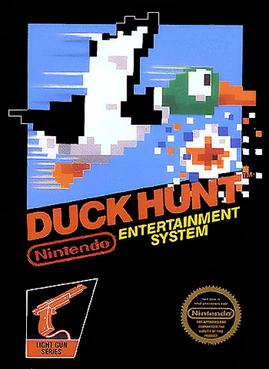
Duck Hunt is a 1984 light gun shooter video game developed and published by Nintendo for the Nintendo Entertainment System (NES) video game console and the Nintendo Vs. System arcade hardware. The game was first released in April 1984, in Japan for the Family Computer (Famicom) console and in North America as an arcade game. It became a launch game for the NES in North America in October 1985, and was re-released in Europe two years later.
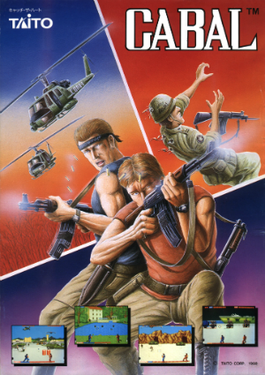
Cabal is a 1988 arcade shooter video game originally developed by TAD Corporation and published in Japan by Taito, in North America by Fabtek and in Europe by Capcom. In the game, the player controls a commando, viewed from behind, trying to destroy various enemy military bases. The game was innovative for the era, but only a mild success in the arcades, and became better known for its various home conversions.
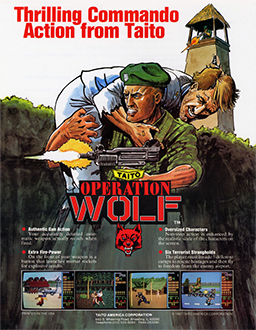
Operation Wolf is a light gun shooter arcade game developed by Taito and released in 1987. It was ported to many home systems.
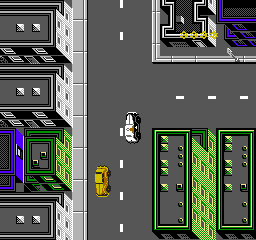
Dick Tracy appeared in the following video game tie-ins for the motion picture:

Jackal, also distributed under the title of Top Gunner, is an overhead run and gun video game by Konami released for arcades in 1986. The player must maneuver an armed jeep in order to rescue prisoners of war (POWs) trapped in enemy territory.

Batman: Return of the Joker is a 1991 platform video game, the follow-up to Sunsoft's first Batman game on the Nintendo Entertainment System. Unlike that game, which was based on the 1989 Batman film directed by Tim Burton, Return of the Joker is entirely self-contained and based more on the modern comic book iteration of Batman, but the Batmobile and the Batwing are featured from the 1989 film. A remake of Return of the Joker, titled Batman: Revenge of the Joker, was released on the Sega Genesis by Ringler Studios in 1992. A Super NES version of Revenge of the Joker was completed but never officially released; a ROM image surfaced online in later years.

The Punisher is a 1993 beat 'em up arcade game developed and released by Capcom. It stars the Marvel Comics' antihero the Punisher and co-stars S.H.I.E.L.D. agent Nick Fury as the second player's character as they embark on a mission to kill the crime lord the Kingpin and bring down his organization. While following the same general formula as Capcom's previous beat 'em ups, the game has a range of usable weapons and a comics-style presentation.

Predator is a 1987 side-scrolling action game based on the 1987 film Predator, and the first game based on the franchise.

Home Alone is the title of several tie-in video games based on the film of the same name written by John Hughes. Versions were released for the Nintendo Entertainment System, Game Boy, Super Nintendo Entertainment System, Master System, Sega Genesis, Game Gear, Amiga, and MS-DOS platforms.

Jurassic Park 2: The Chaos Continues is a 1994 video game and a non-canonical continuation of the Jurassic Park series, developed and published by Ocean Software for the Super Nintendo Entertainment System (SNES). It is a sequel to the SNES game Jurassic Park.

Wild Guns is a 1994 space Western shooting gallery video game developed by Natsume for the Super Nintendo Entertainment System. Set in the Wild West with steampunk and sci-fi influences, the story follows Annie and her bounty hunter Clint, seeking revenge for the death of her family. The player controls either Annie or Clint sidestepping and jumping in the foreground while shooting down enemy robots in the background and dodging enemy bullets. These gameplay mechanics combine elements from third-person shooters and light gun games.

Burai Fighter is a shoot 'em up video game developed by KID for the Nintendo Entertainment System. The game was released in North America by Taxan in March 1990, Europe by Nintendo and Australia by Mattel in 1990, and Japan by Taito on July 20, 1990. The game was also ported to the Game Boy and retitled as Burai Fighter Deluxe, and was released in Japan on June 27, 1990, in North America in January 1991 and in Europe in 1991; this port eventually wound up on the Game Boy Color as Space Marauder, originally released in Japan as Burai Fighter Color, as the original Game Boy version is not compatible with the later models.

Brave Shot is a scrolling shooter mobile phone game developed and published by Square Enix on December 10, 2003. It was released on the Verizon Wireless network in North America. In the game, the player shoots down waves of enemy aircraft, intermixed with giant screen-filling boss fights, while dodging enemy fire. The title was Square Enix's first foray into the North American mobile gaming market, and it was followed by a run and gun sequel, Brave Shot 2, in September 2005. Reviewers praised the game's graphics and exciting gameplay, but criticized the simplicity and uneven difficulty. Reviewers took the game as a positive sign of Square Enix's plans in the mobile gaming market.

Fortified Zone, known in Japan as Ikari no Yōsai is a 1991 video game developed and published by Jaleco for the Game Boy. It was first released in Japan on February 26, 1991 and later released in North America in September 1991. It was later added to the Nintendo 3DS's Virtual Console on July 7, 2011, but the Australia region had it added on July 28, 2011.

Contra III: The Alien Wars is a 1992 run and gun video game developed and published by Konami for the Super Nintendo Entertainment System (SNES). It is the third home console entry in the Contra series after Contra (1988) and Super C (1990) for the Nintendo Entertainment System (NES). In PAL regions, it was retitled Super Probotector: Alien Rebels and the player characters were replaced with robots. The player is tasked with fighting off an alien invasion of Earth across six stages. Four stages feature side-scrolling action traditional to the series while two are presented from an overhead perspective. It is the first Contra title to have been directed by Nobuya Nakazato who later directed other games in the series. He designed Contra III to feature more comical elements, a more cinematic soundtrack, and tighter stage design than its predecessors.

Chikyū Kaihō Gun ZAS is a vertical scrolling shooter video game developed and published by T&E Soft for the Nintendo Game Boy exclusively in Japan on December 18, 1992.
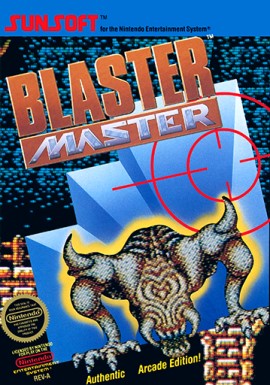
Blaster Master is a platform and run and gun video game released by Sunsoft for the Nintendo Entertainment System. It is a localized version of a Japanese Famicom game titled Chō Wakusei Senki Metafight, which was released on June 17, 1988. The game was released in North America in November 1988 and in Europe on April 25, 1991. The game is the first in the Blaster Master series, and it spawned two spin-off games as well as two sequels.

The Punisher is a 1990 video game developed by Paragon Software and released by MicroProse, which stars the Marvel Comics antihero, the Punisher. An unrelated game for Amiga and Atari ST was released by The Edge also in 1990.

The Punisher: The Ultimate Payback!, released in 1991 by Acclaim Entertainment, is the Game Boy version of the 1990 NES game The Punisher. It follows the Marvel Comics vigilante Frank Castle, also known as the Punisher. Updates after the NES version include cameo appearances of Spider-Man and the final boss was switched from Kingpin to Jigsaw.



















